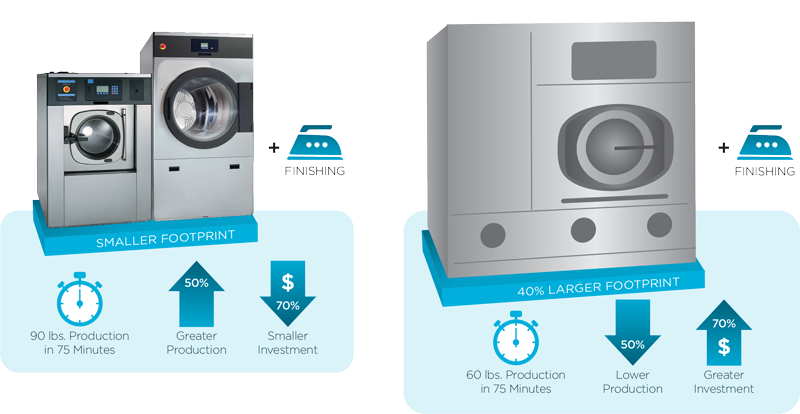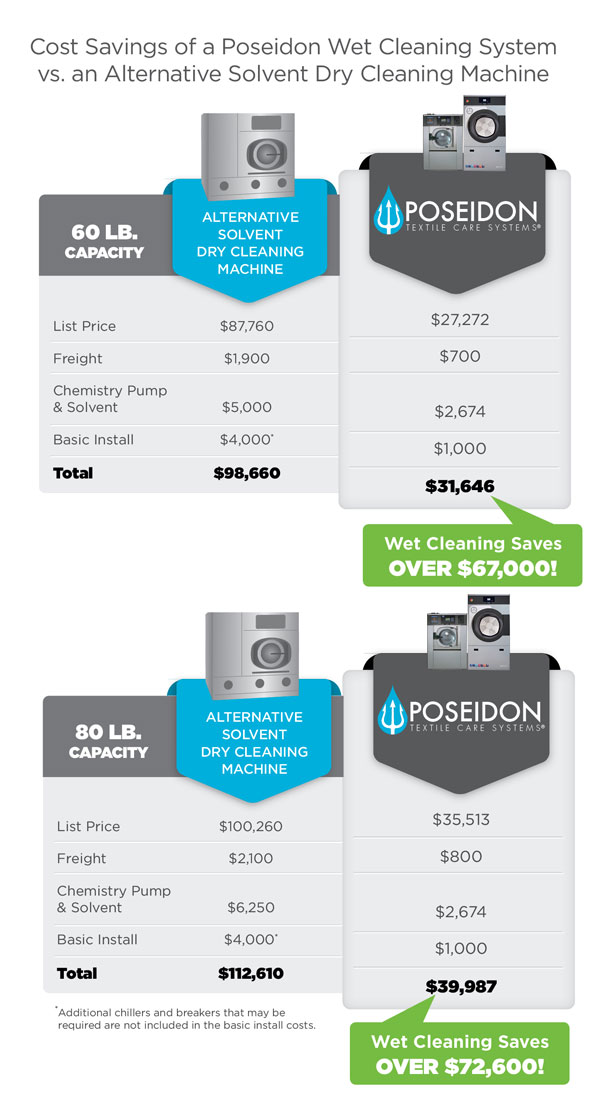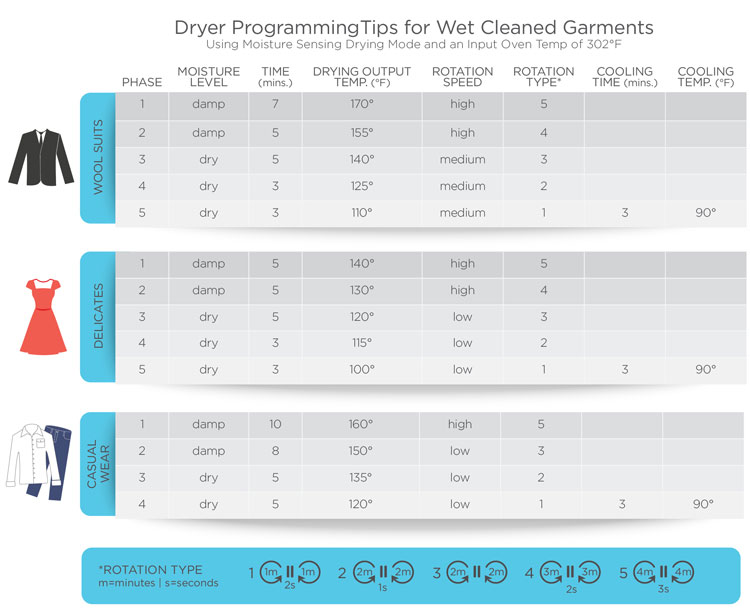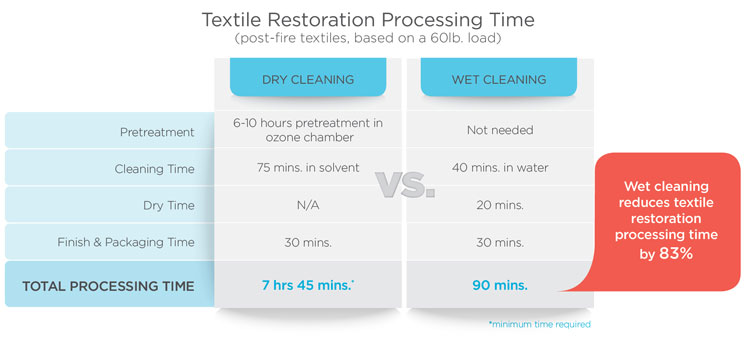Expert Corner
New technologies allow wet cleaning to significantly boost throughput production – at a greater profit margin – when compared to traditional dry cleaning. By growing the percentage of items processed via wet cleaning, textile care facilities are maximizing throughput, lowering utility costs, reducing labor hours, marketing a “greener” operation, and enjoying fatter profits.

In this, the first of a three-part series, Jeff Quail details how today’s wet cleaning technologies elevate plant throughput – over dry cleaning alone – and subsequently open the doors to new business opportunities.
New Technology Makes a Big Impact
Highly programmable wet cleaning machines have been on the market for years. But, they haven’t been utilized to their fullest potential because their partner dryers were seriously lacking … These traditional tumble dryers made it difficult to dry delicate items, such as silks, wools and linens, without damaging them. So, delicate items coming in the door were either air-dried, which took a lot of time and space, or dry cleaned.
New dryer technology, however, is changing the industry’s perception of wet cleaning. For the first time, wet cleaning is a viable processing option for virtually any garment or fabric type. It’s also a great technique for catapulting plant throughput and business opportunity.
Why New Dryers are Changing Perception
Why are the new “wet cleaning” dryers the answer? Because they are completely different than traditional tumble dryers.
As you likely know, garments are most vulnerable when they are fully saturated with water or nearly dry. The new dryers give you the ability to remove moisture quickly, without tumbling, by controlling g-force and drum action. When garments are wet, the drum must spin with just enough G-force so the garments will cling to the drum, rather than fall and tumble from top to bottom. Additionally, new dryers can hit high drum temperatures extremely quickly in order to evaporate moisture without as much tumbling, and programmable moisture sensing ensures items dry to correct moisture levels.
Look for dryers with phased control over the drying process. Each phase should allow programmability of drum rotation speed, drum rotation interval, moisture level, timed reversing, input air temperature, drying temperature, heating temperature, drying time and time limit.
Creating Opportunities via Wet Cleaning
While historically, wet cleaning was not comparable to dry cleaning in terms of results and production, now it is. And, by adding or expanding wet cleaning, traditional dry cleaners are drastically elevating production, and in doing so, creating opportunity.
Most textile care plants use wet cleaning for 10-30 percent of what they process. By turning that up a few notches, really good things can happen. And yes, with the right equipment, fabricare plants are effectively wet cleaning ANYTHING that can be dry cleaned. This includes wool coats, suits, skirts and sweaters, as well as silks, taffeta, cotton, Gortex and linen. Rather than sending out leathers and suedes at $30 to $40 per item, plants successfully wet clean them for less than a dollar each.
Gary Heflin of Perfect Cleaners, in Detroit, has transformed his business from predominately dry cleaning to predominately wet cleaning. He harnesses new wet cleaning/drying technology in his plant and has seen a 50 percent boost in production and 7 percent increase in profits.
“Wet cleaning allows us to finish our work a couple of hours sooner in the day and turn off the boiler, which saves a ton of money on gas and labor,” said Heflin.
Other plant owners are investing in wet cleaning to improve throughput and take on new business.
“The technology for wet cleaning has improved so much, we could operate without a dry cleaning machine,” said Paul White, owner of Lifestyle Garment Care, in Midland, Mich. White recently launched Lifestyle Laundry, which caters to area residents looking for wash/dry/fold services, pickup and delivery. He expects Lifestyle Laundry to double current sales volume using strictly wet cleaning.
And at Belding Cleaners, in Grosse Point, Mich., Joe Hebeka never turns anything away. “Our customers trust us to clean their garments perfectly,” he said. Rather than relying solely on dry cleaning, Belding Cleaners wet cleans 20 percent of incoming items, including wool coats and wedding gowns. “I love wet cleaning wool coats because it is a huge timesaver over dry cleaning,” said Hebeka. “Rather than an hour-long dry cleaning cycle, wool coats go through an 8 minute wet cleaning cycle and 15 minute dry cycle. Finishing them takes hardly any time. Wet cleaning is very important to our growth because we can take on more volume and clean a wider variety of items.”
Like the owners just mentioned, as your comfort level grows, there’s no doubt in my mind that you’ll turn up your wet cleaning production – and with it – your profits and opportunity. My advice? Look at all items that come in the door and cherry pick those you are comfortable wet cleaning. If needed, make appropriate equipment updates. With experience, your confidence will grow and wet cleaning will increase to close to 100 percent.
As co-owner of Poseidon Textile Care Systems®, Jeff Quail is a fabricare, dry cleaning and wet cleaning expert with more than 30 years of hands-on industry operations experience. He is a frequent contributor to industry journals and associations. In this, the first of a three-part series, Quail unveils technology’s impact on wet cleaning and fabricare.
New technologies allow wet cleaning to significantly improve throughput production over traditional dry cleaning. This makes a strong case for the eco-friendly wet cleaning process. But what about the costs associated with wet cleaning versus dry cleaning? When compared – dollar for dollar – wet cleaning is thousands less.
Initial Investment
First, let’s evaluate the initial cost of each system. This is the amount required to purchase new alternative-solvent dry cleaning machines versus similarly sized Poseidon wet cleaning systems. When the numbers are crunched, there’s a $67,000-$72,000 cost differential in favor of Poseidon wet cleaning. But that’s just the tip of the iceberg. Let’s dig deeper.

1. Additional Capital Expenditures
Often, there are additional costs associated with operating a new dry cleaning machine, including upgrading boilers, chillers, air compressors and electrical. If you have to upgrade any of these because of your new dry cleaning machine, you’ll fork out considerably more. Whereas, if you go with a wet cleaning system, you won’t.
For example, a customer is installing an 80-pound capacity dry cleaning machine at a cost north of $100,000 list price. It’s going into an existing facility. To operate correctly, the dry cleaning machine will require the purchase of another chiller ($16,000) and an 80 amp breaker. Additionally, the new chiller will require another 70 amp breaker. In the end, the new dry cleaning machine not only requires a new chiller, it demands a costly electrical upgrade. All this adds up.
By comparison, an 80-pound capacity Poseidon wet cleaning system, which operates on 15 amp breakers, doesn’t require anything extra. So, if you add a wet cleaning system, you’ll likely not have to purchase or upgrade anything else.
2. Operational Costs
We know that the minimal initial investment of a 60-pound capacity dry cleaning machine is at least $60,000 greater than that of a similarly sized wet cleaning system. We also know other capital expenditures and upgrades are also part of the installation and operational equation. Now, let’s compare labor, chemistry/solvent, regulatory/licensing fees and utility costs.
Chemistry – Initial start-up costs for chemistry for a 60-pound wet cleaning machine is around $2,500. It’s $5,000 for a 60-pound dry cleaning machine. From there on, there is not a huge difference.
Water – Water usage can vary. On the dry cleaning side, when a chiller is utilized to recycle water through a dry cleaning machine, very little water is used. But, a chiller costs between $15,000 and $30,000.
In general, a 60-pound wet cleaning machine uses 40 gallons of water per load, and over the course of a year, would go through as much water as a dry cleaning machine hooked to a water tower. A dry cleaning machine hooked to a chiller is the most water efficient. The only problem is that this scenario requires a costly initial investment.
Electricity – When it comes to electricity, wet cleaning comes out ahead. This is because a dry cleaning machine requires 60-90 amps to operate, whereas a wet cleaning system requires just 15.
Natural Gas – The boiler needed to operate a dry cleaning machine uses 670,000 BTUs, which dwarfs the wet cleaning requirement of 118,000 BTUs. Plus, a boiler will run until all plant production is completed for the day. A wet cleaning system dryer operates in 15-20 minute increments a dozen times a day. Again, wet cleaning wins.
Labor – When compared, labor costs are very similar in both dry cleaning and wet cleaning.
3. Regulatory & Waste Disposal Fees
Finally, regulatory fees and waste disposal costs are not uniform across the country because each state has its own set of laws. Typically, it costs hundreds per drum for removal of dry cleaning still-bottom-solvent wastes.
On the flip side, there are never disposal or regulatory costs for wet cleaning.
Wet Cleaning – a Third of the Cost of Dry Cleaning
At the end of the day – when all factors are considered – wet cleaning costs are thousands less than those of dry cleaning. Plus, wet cleaning delivers 50 percent more throughput. That’s a one-two punch that’s hard to reckon with.
While highly programmable wet cleaning washer-extractors have been on the market for years, their partner dryers have lacked the programmability needed to dry delicate fabrics – wools, silks, linens – without resulting damage. Historically, garments were either wet cleaned and air-dried overnight, which took a lot of time and space, or dry cleaned. Thankfully, emerging dryer technology is changing all that … It’s revolutionizing the wet cleaning process and how textile care operators do business.

Initial Investment
Read on to discover what new dryer features and capabilities are now available and how they truly perfect the wet cleaning process – making it quicker and more effective than ever. Simultaneously, learn methods for customizing dryer programs for superior results – leaving garments relaxed, soft and primed for finishing.
Dryer Programmability Matters
Dryer programmability is finally catching up to the programmability level of a wet cleaning washer. For the first time, there are dryers on the market offering several programmable phases in the drying process, as well as sophisticated control over multiple variables within those phases, including oven temperature, drum temperature, drum rotation action and G-force, timed reversing, and moisture sensing control technology. Many of these drying variables have never been offered before and most have not been programmable.
Productivity, Efficiency & Results
By controlling variables by phase, even the most delicate items can be dried to the proper moisture level that’s ideal for finishing. This means textile care operations can wet clean garments more quickly and efficiently, provide improved customer turnaround times, become more environmentally friendly and lower operational costs. Because the new dryers eliminate air drying, it takes wet cleaning to a whole new level of productivity. Simultaneously, thanks to new dryer technology, the wet cleaning process is 50 percent more productive than dry cleaning and just as effective in ensuring a quality result.
Let’s take wool suits as an example. With a new dryer technology, a load of wool suits takes just 15 minutes to wet clean, 15 minutes to dry and less than 10 minutes to finish. The new dryers make it possible to turnaround a suit – from drop off to pick up – in an hour. That cannot be achieved using today’s dry cleaning machines, as they typically mandate a 75-minute cycle before sending garments to finishing.
If the 50 percent wet cleaning production hike isn’t tempting enough, consider the added convenience provided to customers. Plus, the results are as good or better than dry cleaning.
Essential Dryer Capabilities
So, what are the key capabilities to look for? Seek out dryers with programmability of multiple variables within each phase of the drying process. Programmable phases, beyond the typical dry and cool down, allow for the control necessary to protect garments when they are their most vulnerable – at the beginning of the dry cycle when they are saturated with water and at the end of the cycle when they are near dry. Poseidon dryers, for example, offer up to 11 phases. A minimum of five phases are essential:
Critical Programmable Features
To deliver great results, look for a dryer with the following programmable features within each phase.
1. Drum Rotation Speed (RPMs) & Interval – By controlling drum speed and interval, you can remove moisture quickly, without tumbling. This is important. When garments are wet, the drum should ideally spin with enough RPMs to cause garments to cling to the drum, rather than fall and tumble from top to bottom. This prevents damage and shrinkage. Drum speed should be adjustable based on phase, item type, moisture content and fabric.
2. Moisture Level – It’s important for a dryer to have the ability to check and confirm the moisture content of a load before advancing to the next phase. Most dryers monitor for one moisture level throughout the entire dry cycle. Now, thanks to new technology, each phase has its own moisture level setting. This eliminates over drying, shrinking and damage at all phases of the drying process.
3. Timed Reversing –
When the drum only turns in one direction, garments tangle and ball up, creating uneven drying. Look for a dryer with multiple different reversing options.
4. Input (Oven) & Output (Drum)Temperature
– Most dryers allow control over the drum temperature for a set period of time. But, it isn’t enough. A dryer with programmable oven temperature, from 104-392°F, allows total control over the dryer heat source/flame, which greatly reduces the risk of hot spots and heating inconsistencies that contribute to garment damage or shrinkage. Typically, oven temperature is higher for thicker materials and lower for delicate garments.Additionally, new dryers can hit high drum temperatures (up to 195°F) extremely quickly in order to evaporate moisture without as much tumbling. This precise control over temperature, rotation action and drum speed protects garments from damage while allowing the shortest dry times.
5. Time Limit – It goes without saying that the duration of each phase is important. New technology allows cycles to advance to the next phase based on time limit or moisture level. A time limit is always programmed to prevent over drying due to a possible moisture sensing error. This redundancy is an additional safeguard against damaging garments.
Seeking new ways to bolster revenue, fabricare professionals are entering the textile restoration market in droves. In doing so, they work with homeowners and insurance companies to clean and restore household soft goods (clothing, window coverings, bedding, towels, etc.) following a flood or fire. The goal? To restore items to pre-incident condition at a fraction of the cost of replacement, and to do it in the most efficient, productive and profitable way possible.

That’s just good business. And thanks to recent advancements in chemicals and dryer programmability, more than 90 percent of contaminated textiles can be restored to pre-loss condition using water. All durable goods, bedding, towels, typical wash-and-wear items, as well as traditionally dry cleaned items, including wool suits, designer silk dresses and wedding gowns, can now be safely wet cleaned.
The good news? Using water – not solvent – is not only less costly and more environmentally friendly, it’s also more productive and efficient. Both are effective restoration methods, but at the end of the day, a textile restoration cleaner will generate more profit using wet cleaning over dry cleaning.
Thanks to today’s technologies, plants can wet clean more quickly and cost-effectively than dry cleaning. Wet cleaning can boost production 50 percent over alternative-solvent dry cleaning. Moreover, wet cleaning outperforms dry cleaning without the negative environmental impact.
A Look at Dry Cleaning
The steps involved with dry cleaning, although effective, are more involved and take more time. In order to restore post-fire textiles using dry cleaning, textiles must be pre-treated overnight in an ozone chamber. The ozone works to remove the odors – something dry cleaning alone can’t accomplish – but adds hours to the textile restoration process. The ozone step is a must for post-fire textiles, but not always a must for post-flood textiles.
After treatment inside the ozone chamber, items are sorted and loaded into a dry cleaning machine that uses solvent, not water, to clean. After another 60-75 minutes inside the dry cleaning machine, the load is removed, finished and packaged.
Using a 60-pound capacity dry cleaning machine, it takes 75 minutes to clean, finish and package 60 pounds of textiles. The total time to completion, including the ozone step, is anywhere from 8 to 12 hours.
More Productive Wet Cleaning
When wet cleaning is used, there is no need to pre-treat with ozone because wet cleaning alone effectively removes the worst odors, including smoke. Instead, textiles are sorted and loaded into a highly programmable wet cleaning machine, which is programmed to automatically combine the right water levels, water temperatures, rotation action, extract speed, number of baths and rinses, and cleaning chemicals. Once the load is complete, after 30-40 minutes, the textiles are loaded into a highly programmable dryer. In the past, it was difficult to dry delicate items, such as silks, wools and linens, without damaging them. But, thanks to new dryer advancements, this isn’t the case anymore. New technology offers phased control over the drying process, and each phase allows programmability of drum rotation speed, drum rotation interval, moisture level, timed reversing, input air temperature, drying temperature, heating temperature, drying time and time limit. In around 20 minutes, drying is complete and textiles are unloaded, finished and packaged.
Using a 60-pound capacity wet cleaning machine and a 60-pound capacity dryer, it takes just 60 minutes to process and finish 60 pounds of textiles.
Apples to Apples Production Comparison
Comparing the two methods side by side, wet cleaning is clearly superior in terms of productivity. Even without the ozone step that’s often required when using dry cleaning, wet cleaning processes are 50 percent more productive than dry cleaning.
Contaminants & Best Practices
Now, let’s determine whether wet cleaning is an effective method for restoring heavily contaminated textiles. Flood, fire and smoke contaminants pose an immediate danger to human health because they can leave microbes, mold and cancer-causing contaminants behind. Floodwaters often mix with contaminants on the ground, including pesticides, sewage and trash. Even after the floodwaters recede, the microbes and mold that are left behind on clothing and textiles can spur allergic reactions, irritation, gastrointestinal disease, as well as respiratory and soft-tissue infections. Fires, on the other hand, often leave textiles stinking of smoke and infiltrated with an array of carcinogens, particulates and toxic chemicals.
Let’s tackle biohazards, like bacteria and viruses, first.
R.R. Street & Co. Inc. (Street), a leading provider of textile care cleaning chemicals, provides chemical treatments and additives specifically designed to kill microorganisms. “These EPA-registered bactericidal chemicals demonstrate a microorganismal kill rate of 99.9 percent,” said James Schulte, Street’s lead chemist.
In wet cleaning and dry cleaning, these chemicals work in concert with water or solvent, water or solvent temperature, mechanical action and cycle time to significantly reduce or eliminate bacteria, viruses and mold in affected clothing. Thus, both wet cleaning and dry cleaning are highly effective for removing biohazards. But what about the chemicals, particulates and carcinogens often left behind after a fire?
After conducting numerous scientific studies over the years, the National Fire Protection Agency (NFPA) determined that the most effective method for cleaning firefighter protective gear, was by using a highly programmable washer-extractor. The NFPA subsequently published a set of guidelines (NFPA 1851) which detail specifics for cleaning such gear. The synopsis? The NFPA recommends fire departments wash protective gear immediately after exposure to fire. Dry cleaning is not a method recommended by NFPA.
Once gear is wet cleaned, the NFPA recommends that it is air dried, or dried using ambient air. It can also be dried in a programmable dryer using a no-heat setting and limited rotation. Drying is critical because it provides garments the chance to off-gas and decontaminate further, according to the NFPA. In a nutshell, the NFPA recommends that firefighter protective gear be wet cleaned, not dry cleaned. Their goal? To keep firefighters safe from fire contaminants.
It seems to me that textile restoration practices should follow the same guidelines – based on scientific research – to keep people safe.
Say Yes to Wet Cleaning
Let’s review the facts. Today, new technologies make it safe to wet clean even the most delicate fabrics. We also know that wet cleaning is as effective as dry cleaning for removing biohazards, and more effective than dry cleaning for removing post-fire contaminants and odor. Moreover, wet cleaning is vastly more productive, which allows textile restoration operations to complete orders more quickly, generate more revenue and provide improved customer service. At the end of the day, wet cleaning should be used to restore the vast majority of household textiles.